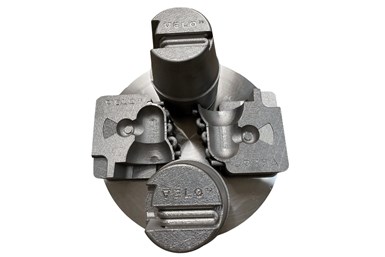Velo3D Qualifies M300 Tool Steel for Use in Sapphire Printers
The company says the high-strength alloy combined with Velo3D’s end-to-end solution can improve the lifetime of tooling inserts and enhance manufacturing throughput for automotive manufacturers.
Share
Read Next
An M300 tool steel print of conformal cooled tooling and high pressure die casting inserts. The print is shown as printed on the build plate. Photo Credit: Velo3D
Velo3D has qualified M300 tool steel for use in the company’s Sapphire series printers. M300 tool steel is an ultra-low carbon alloy with very high strength and hardness properties derived from intermetallic compounds rather than carbon content. The material is comprised mainly of nickel with cobalt with molybdenum and titanium as secondary intermetallic alloying metals.
By qualifying M300 tool steel for use in its printers, the company says it is able to service entirely new industries, such as automotive and tooling. The company says users can leverage its advanced capability to print high-quality, large-diameter internal channels for their applications. By manufacturing die cast inserts and other tooling components with the technology, it is said companies will be able to build stronger products, improve machining throughput and decrease manufacturing costs.
The alloy is well suited for tooling applications such as high pressure die cast (HPDC) inserts, injection molding, and other types of tooling. The company says its end-to-end manufacturing solution enables companies to build the parts they need without compromising design or quality — resulting in complex parts higher in performance than traditional casting techniques or other additive methods.
The company’s printing technology is said to work well with the M300 tool steel due to its ability to print parts with high-quality surface finishes in complex, large-diameter internal cooling channels, which can prolong the life of the tooling. However, the company says the channels can be difficult to create with conventional manufacturing methods. Also, while other metal 3D printers can print smaller diameter holes, printing large channels can create roughness and susceptibility to cracking. The Sapphire printers are said to eliminate those issues.
The company’s Sapphire XC 1MZ, for example, offers a large build volume — 600 mm in diameter and 1,000 mm in height. This is said to make it well suited to fulfill the requirements of industries that require the largest M300 tool steel inserts, such as automotive.
Related Content
-
Seurat: Speed Is How AM Competes Against Machining, Casting, Forging
“We don’t ask for DFAM first,” says CEO. A new Boston-area additive manufacturing factory will deliver high-volume metal part production at unit costs beating conventional processes.
-
Do Distributors Dream of Digital Inventory? Würth Additive Group Does
It’s more than a dream for Würth Additive Group and its parent company, in fact. Along with supplying additive equipment, the group is now developing solutions for sourcing 3D printed parts in a reliable, elastic digital inventory model.
-
A Tour of The Stratasys Direct Manufacturing Facility
The company's Belton manufacturing site in Texas is growing to support its various 3D printing applications for mass production in industries such as automotive and aerospace.
















